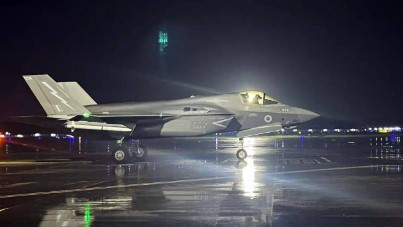A British Royal Navy F-35B fighter jet has been stuck at Thiruvananthapuram International Airport in Kerala for the past five days.
F-35B Fighter Jet Stranded in India
The aircraft had landed unexpectedly and has not moved since. What’s unusual is that the jet is not being kept in a protected hangar. Instead, it is parked out in the open, even during heavy rains.
According to sources from idrw.org, Indian authorities had offered to shift the advanced fighter jet into a hangar. This would have protected it from the weather and made it easier for the British technical team to fix it. But the British Royal Navy reportedly said no to this idea. The reasons for this refusal have not been officially explained.
The British technical team arrived from the United Kingdom on the third day. However, they could not begin the repair work due to the ongoing monsoon rains. The rains have made it difficult to safely access or work on the sensitive aircraft. The Indian Air Force (IAF) even offered to set up a temporary shed to cover the area and help the ground crew. This offer too was turned down by the Royal Navy.
The jet is now sitting in a less crowded part of the airport. Security personnel from the Central Industrial Security Force (CISF) have been posted around the aircraft to make sure it stays safe. No passengers or other aircraft have been affected by the jet’s presence so far.
✈️ Game Over for Stealth? India’s Radar Detects F-35, China’s J-35 Faces Reality Check
Rain Disrupts Repairs of F-35B
The F-35B is one of the most advanced fighter jets in the world. It can take off and land vertically, much like a helicopter. This makes it useful for operations from aircraft carriers. But it is also very complex and needs skilled technicians and special tools for even small repairs.
Because the British team cannot work in the open during heavy rains, repairs have been delayed. The aircraft remains exposed to strong winds, rain, and humidity. These weather conditions can damage the plane’s systems, including its radar, sensors, and electronic controls.
Despite the risk, no action has been taken to protect the jet with even temporary cover. The reason for this inaction is still unknown. Experts believe that the Royal Navy may have strict rules or security concerns. However, none of this has been officially confirmed.
Both British and Indian officials have avoided making public statements. This silence has led to many questions, with no clear answers. Some people think this may be due to sensitive military protocols. Others say it could be related to international agreements or chains of command. Still, nothing has been said by either side to explain the exact situation.
Diplomatic Tensions or Caution?
The refusal to move the F-35B into a hangar or use a temporary shed has surprised many. India has previously worked with international forces on similar matters and often helps foreign military aircraft with emergency repairs. Allowing the aircraft into a hangar is common practice in such situations, especially when there are safety and weather-related concerns.
However, the British side’s decision to leave the plane in the open has raised eyebrows. The jet, a piece of high-tech equipment worth millions of dollars, is now at risk of damage from natural elements. This may affect the systems onboard, especially if moisture enters critical parts of the aircraft.
Security has been increased around the jet. CISF personnel have formed a tight perimeter to keep unauthorized persons away. Surveillance has also been stepped up, and airport operations continue without disruption.
British F-35B Jets Bolster NATO Air Defense in Iceland
This incident also shows how military cooperation can face unexpected roadblocks. While countries often help each other in such situations, each side may follow different rules and procedures. This can lead to delays and confusion, especially in high-security cases involving modern military technology.
So far, the jet remains grounded. It has not been moved from its current position. The British team continues to wait for suitable conditions to begin repair work. There is no update on how long the jet will remain at the airport or when it will be fit to fly again.
As it stands, the F-35B continues to sit in the rain, watched over by Indian security forces, with no clear solution in sight. The lack of official explanation from both sides has kept observers guessing.
